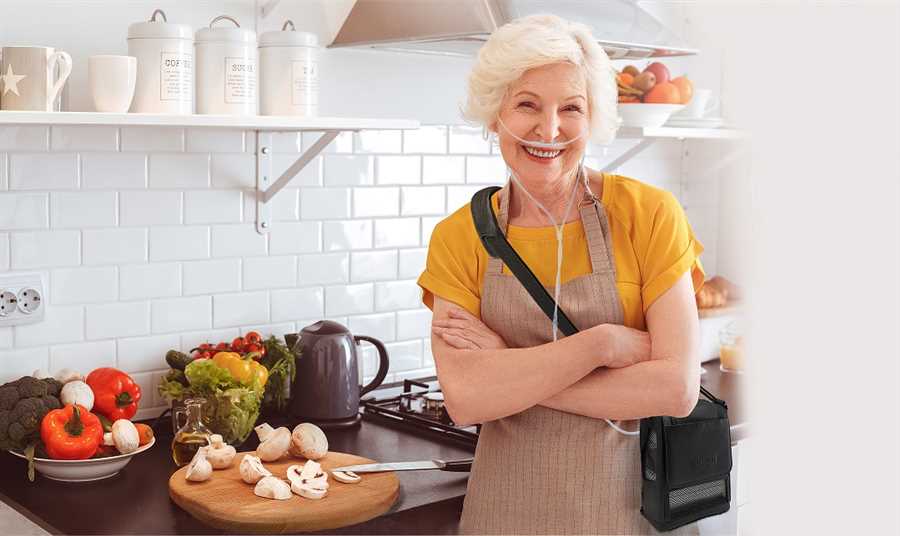For individuals who rely on oxygen therapy, maintaining independence and participating in daily activities can be a significant concern. Cooking is one such activity that often raises questions and apprehension. Can you cook while on oxygen? The answer is yes, but certain precautions need to be taken to ensure safety.
Firstly, it is essential to inform your healthcare provider and oxygen supply company about your intention to cook while on oxygen. They can provide guidance and ensure that the equipment and oxygen flow rates are adjusted accordingly. It is also important to have a fire extinguisher nearby and to familiarize yourself with its proper use.
While cooking, it is crucial to keep oxygen equipment at least 6 feet away from any open flame or heat source, such as stovetops, ovens, or grills. This distance helps mitigate the risk of fire or damage to the oxygen tubing from heat. Additionally, avoid using any oils or flammable cooking sprays near the oxygen equipment.
Furthermore, be mindful of any loose clothing that might come into contact with open flames or hot surfaces. Wearing snug-fitting clothing, tying back long hair, and protecting your face with a cooking shield can help reduce the risk of accidents or injury.
Is it safe to cook while using oxygen?
Using oxygen in the home can be necessary for individuals with certain respiratory conditions or illnesses. While oxygen therapy can improve quality of life and help with breathing, it is important to be aware of certain safety precautions, especially when it comes to cooking.
Potential risks:
1. Fire hazards: Oxygen can support combustion, which means it can make a fire burn faster and hotter. If there is a fuel source and an ignition source present, fires can start more easily and spread more rapidly in the presence of oxygen. This poses a significant risk when cooking, as there are typically multiple fuel sources (such as gas, oil, or even grease) and an open flame or heating element.
2. Oxygen concentrator safety: Oxygen concentrators are commonly used for oxygen therapy at home. These devices draw in air from the surroundings, filter out other gases, and deliver concentrated oxygen through a nasal cannula or mask. However, oxygen concentrators also produce heat, which can pose a risk if placed too close to flammable materials in the kitchen.
Safety precautions:
1. Keep oxygen away from flames and heat sources: It is crucial to maintain a safe distance between oxygen equipment and any sources of flame or heat in the kitchen. This includes stovetops, ovens, grills, and candles. Store oxygen cylinders or concentrators in well-ventilated areas away from potential ignition sources.
2. Inform others in the household: Ensure that everyone in the household is aware of the risks associated with cooking while using oxygen. Educate family members or caregivers on how to handle and store oxygen equipment properly. It is also essential to have a clear emergency plan in place in case of a fire or any other safety issue.
3. Maintain good ventilation: Proper ventilation can help prevent the buildup of flammable gases, such as natural gas, propane, or butane, that can be released while cooking. Ensure that the kitchen is adequately ventilated and consider using an exhaust fan or opening windows to improve air circulation.
4. Use appliances and tools safely: Be cautious when using appliances such as stovetops, ovens, and toasters. Avoid wearing loose clothing that may catch fire easily and keep flammable materials, such as kitchen towels or curtains, away from heat sources. Follow all safety instructions provided by the appliance manufacturer.
In conclusion, cooking while using oxygen can pose certain risks due to the flammable nature of oxygen and the potential for fire hazards in the kitchen. By taking proper safety precautions and being mindful of potential risks, it is possible to safely cook while using oxygen therapy at home.
Understanding the risks
When cooking while using oxygen therapy, it is important to understand the risks involved. While oxygen itself is not flammable, it supports combustion, making fires burn more easily and quickly. This means that if a fire were to occur while you are cooking with oxygen, it could spread rapidly and become more dangerous.
One of the greatest risks of cooking with oxygen is the potential for clothing or other materials to come into contact with heat sources, such as a stovetop or oven. Oxygen tubing or nasal cannulas can catch fire and lead to serious injuries or even death. It is crucial to keep a safe distance between your oxygen equipment and any heat sources while cooking.
Another risk to consider is the possibility of oxygen leaks or equipment malfunctions that can lead to an increased concentration of oxygen in the air. This can create an environment where materials that wouldn’t normally burn easily can ignite more readily. It is important to regularly check your oxygen equipment for any signs of damage or malfunction and to follow the manufacturer’s instructions for proper use and maintenance.
In addition to fire hazards, cooking while on oxygen therapy can pose other risks. Activities such as carrying heavy pots or pans, reaching for items in high cabinets, or standing for long periods of time can be physically demanding and may increase the risk of falls or accidents. It is important to take precautions and make any necessary modifications to your cooking environment to ensure your safety.
Lastly, it is essential to be aware of the potential for oxygen to displace other gases, particularly in small spaces. Oxygen concentrators can produce concentrated oxygen, which can lead to a decrease in the concentration of other gases, such as nitrogen, in the air. This can increase the risk of oxygen toxicity or other medical complications. It is important to ensure proper ventilation when cooking with oxygen therapy.
| Risks | Recommendations |
|---|---|
| Fire hazards | – Keep a safe distance between oxygen equipment and heat sources – Regularly check equipment for damage or malfunction |
| Physical risks | – Take precautions and modify cooking environment – Avoid carrying heavy items or reaching for high cabinets |
| Gas displacement | – Ensure proper ventilation – Be aware of oxygen concentrators producing concentrated oxygen |
Precautions to take
When cooking while on oxygen, there are several precautions you should take to ensure your safety and minimize the risk of accidents. These precautions include:
|
1. Keep oxygen equipment away from heat sources Make sure your oxygen equipment, such as tanks or concentrators, is kept at a safe distance from heat sources in the kitchen, such as stovetops, ovens, or open flames. Heat can increase the risk of fire or explosion, so it’s important to keep them separated. |
|
2. Use electric appliances instead of gas Consider using electric appliances, such as electric stovetops or microwaves, instead of gas-powered appliances. Gas can be more dangerous in terms of fire risk, so using electric appliances can help minimize that risk. |
|
3. Avoid loose clothing or dangling cords Wearing loose clothing or having dangling cords near heat sources can also increase the risk of fire. Make sure to wear fitted clothing and keep cords away from burners or other hot surfaces to prevent accidental ignition. |
|
4. Keep a fire extinguisher nearby It’s always a good idea to have a fire extinguisher in the kitchen, especially when cooking while on oxygen. Make sure it is easily accessible and that you know how to use it. In the event of a fire, you can use it to quickly extinguish small flames before they spread. |
|
5. Follow proper ventilation practices Ensure that your kitchen is well-ventilated to avoid a buildup of oxygen or other gases. Proper ventilation can help reduce the risk of fire or explosion. Open windows or use exhaust fans to remove any fumes or gases from the cooking area. |
By taking these precautions, you can safely cook while on oxygen and enjoy your meals without compromising your well-being.
Safe cooking practices
When cooking while on oxygen, it is important to follow certain safe practices to prevent accidents and ensure your safety. Here are some guidelines to keep in mind:
-
Keep oxygen equipment away from heat sources
Ensure that your oxygen equipment, such as tanks or concentrators, is kept at a safe distance from heat sources in the kitchen. This includes stovetops, ovens, and other cooking appliances. Oxygen supports combustion, so keeping it away from open flames or hot surfaces can help minimize the risk of fire.
-
Do not smoke or allow others to smoke in the kitchen
Smoking should be strictly prohibited in the kitchen while using oxygen. Smoking near oxygen equipment can lead to fire and serious injuries. It is important to have a smoke-free environment to reduce the risk of accidents.
-
Avoid wearing loose, flowing clothes

Loose or flowing clothes can easily catch fire while cooking. It is recommended to wear close-fitted clothes or aprons without long, loose sleeves. This can help prevent accidental contact with flames or hot surfaces.
-
Keep the kitchen clean and free of clutter
A clutter-free kitchen minimizes the risk of accidents. Make sure the countertops, stovetops, and other cooking areas are clean and free from grease, spills, or other potential hazards. Regularly clean your cooking equipment to avoid any fire hazards.
-
Stay vigilant and attentive while cooking

It is vital to stay focused and attentive while cooking, especially if you are on oxygen. Avoid leaving cooking unattended to reduce the risk of fires. Use timers or reminders to help you remember to check on your food regularly.
-
Have a fire extinguisher nearby
Keeping a fire extinguisher in the kitchen is a wise precautionary measure. Make sure it is easily accessible and check its expiration date regularly. Knowing how to use a fire extinguisher properly is also important.
-
Consult with a healthcare professional
It is always advisable to consult with your healthcare professional if you have any concerns or questions about cooking while on oxygen. They can provide specific guidelines based on your individual needs and ensure your safety.
By following these safe cooking practices, you can enjoy cooking while on oxygen without compromising your well-being.
Questions and answers
Can you cook while on oxygen?
Yes, it is possible to cook while on oxygen, but there are safety precautions that should be followed.
What safety precautions should be taken when cooking while on oxygen?
When cooking while on oxygen, it is important to keep the oxygen equipment at least six feet away from any heat source, such as stoves and ovens. It is also important to avoid using flammable oils or sprays while cooking.
Is it safe to use the oven while on oxygen?
Using the oven while on oxygen can be safe if proper precautions are taken. Make sure to keep the oxygen equipment far enough away from the oven and avoid any potential sources of ignition.
Are there any cooking methods that should be avoided while on oxygen?
It is best to avoid cooking methods that involve open flames, such as grilling or deep-frying, while on oxygen. These methods can pose a higher risk of fire.
What can I do to minimize the risks of cooking while on oxygen?
To minimize the risks of cooking while on oxygen, it is important to always follow the safety guidelines provided by your healthcare provider. Keeping the oxygen equipment away from heat sources, using caution with flammable materials, and having a fire extinguisher nearby can help reduce the risks.
Is it safe to cook while using oxygen?
Yes, it is generally safe to cook while using oxygen as long as certain precautions are taken. Oxygen itself is not flammable, but it can cause a fire to burn more quickly if it comes into contact with a flame. It is important to keep the oxygen source at a safe distance from any open flames or heat sources.






